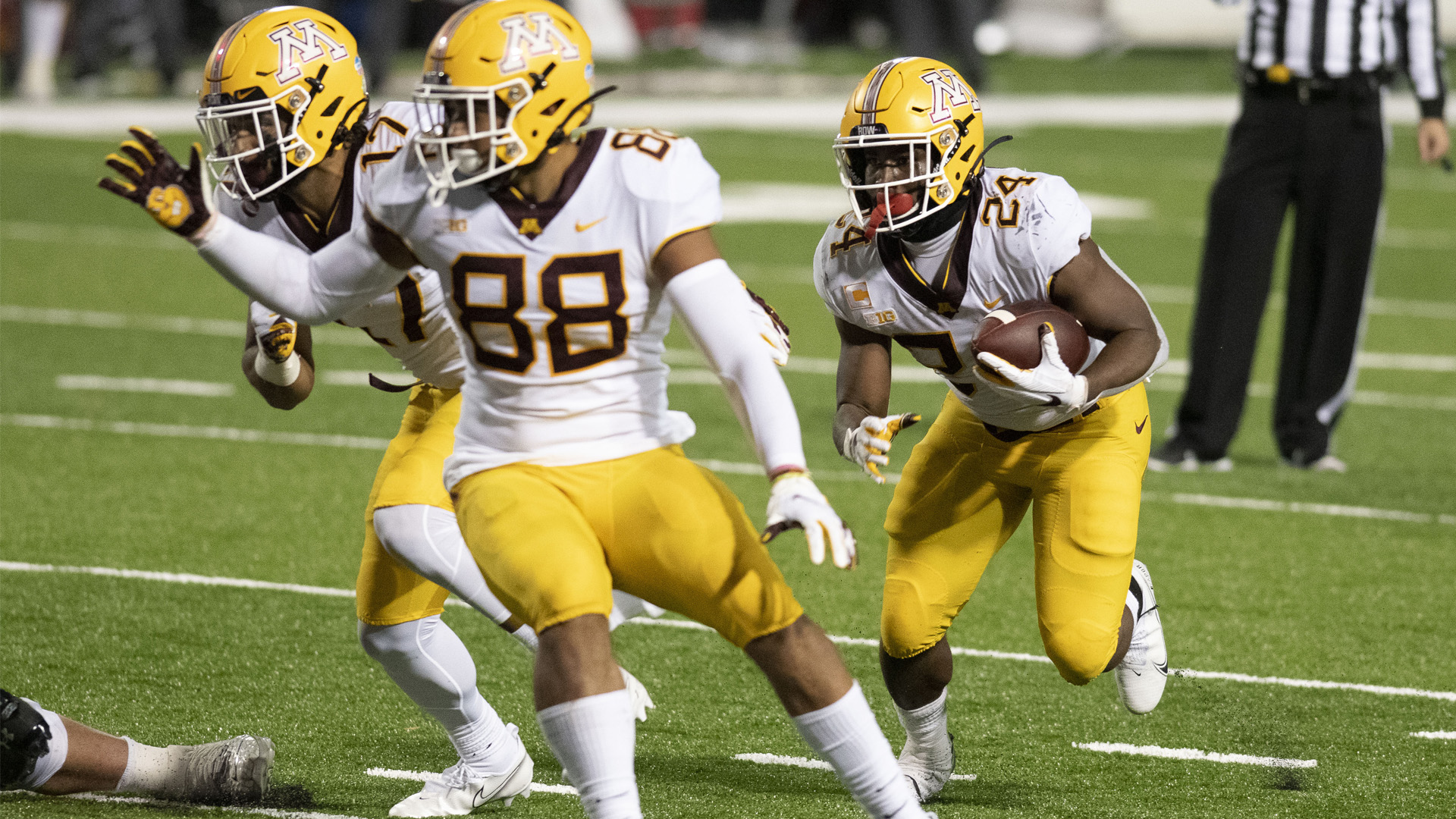Ad Disclosure

Thanks to a bevy of youth on the defensive side of the ball and an invisible, contagious “ball” that’s measured in nanometers, the Minnesota football program spent the better part of 2020 trying to live in two different worlds simultaneously.
Check with Thor and see how that’s working out for him.
The departure of multiple NFL-level talents on defense left the Golden Gophers with a lot of gaps to plug on that side of the ball. Then came COVID-19, which hit Minnesota as hard as any program in the country, turning its schedule into a shell and forcing it to play severely shorthanded down the stretch.
What’s on the agenda for 2021, then? Some stability, for one. Here are 5 offseason priorities coach P.J. Fleck, his staff and his players will surely focus on in the coming weeks and months.
1. Develop those wide receivers
The most glaring change between Minnesota’s illustrious 2019 offensive output and 2020 wasn’t the offensive line that was missing two starters. Nor was it the graduation of storied running backs Rodney Smith and Shannon Brooks.
It was the passing game.
En route to an 11-2 finish, the Gophers threw for over 250 yards per game two seasons ago. In 2020, they couldn’t crack 200.
Quarterback Tanner Morgan was off at times. But it became apparent as the season wore on he didn’t always trust receivers not named Rashod Bateman or Chris Autman-Bell.
The former is headed for a likely first-round NFL draft selection. The latter is back, but behind him, it’s imperative that guys such as Daniel Jackson and Michael Brown-Stephens take the step from once-a-game flash to consistent part of the solution.
That means plenty of strength and agility workouts on their freshman frames, and as many routes with Morgan as possible during the spring and summer.
2. Secure an immediate defensive difference-maker
It’s agonizingly common knowledge for Gophers fans by now, but we’ll repeat it for reference’s sake: Minnesota had one of FBS’s worst defenses in 2020.
That includes an astounding 6.9 yards per play for opponents, ranking 121st out of 127 teams.
Coordinator Joe Rossi Jr.’s unit needs help. And it needs it fast.
If there’s a good time to deal with the chaos that is the NCAA transfer portal, this is it. The obvious choice would be a linebacker, but anyone in the front seven who can either stuff run gaps or come up and fill them would be an improvement. Combine a successful transfer project with development of the scores of freshmen who played in 2020, and the Gophers could be in for a nice turnaround.
The only way to go, really, is up.
3. Find a kicker(s)
COVID-19 made sure the kicker position was a revolving door in Dinkytown for the second straight season. Five players attempted a field goal, extra point, and/or a kickoff last season.
None of them was consistent.
Brock Walker (2-for-3 on field goals) might be the answer if he’s healthy; the sophomore was recovering from sports hernia surgery during the season.
Michael Lantz is also back. But he and Walker each missed an extra point and couldn’t notch a touchback in shared kickoff duties with Dragan Kesich. Kesich, a freshman last season, returns, too, and has a strong leg.
But Minnesota couldn’t rely on its kickers in clutch situations — see the overtime loss to Maryland — and ranked 107th in FBS in kickoff yardage. So all options should be on the table.
4. Get the offensive line healthy
Morgan, who looked a lot like his old self by season’s end, and Big Ten running back of the year Mohamed Ibrahim are both back in 2021. So is the bulk of an offensive line that returned all five starters heading into 2020.
Then came a season-ending injury to Curtis Dunlap Jr. and the COVID-related absence of Daniel Faalele all season. If those two and the rest of the gang are all back — and healthy — in 2021, look out.
5. Execute a safe, drama-free spring practice schedule
Yes, this of course applies to every FBS program in the country. But it’s especially imperative for Minnesota for the following reasons:
- The Gophers are still young as heck on defense. Their inexperience cost them multiple games, and the lack of preparation showed.
- Morgan needs as much time with this group of receivers as possible.
- Fleck is entering his fourth season at the helm. The roster is about to turn over to a lot of his recruits, and he can’t afford any further delays in getting them up to speed on the playbook and ingratiated into the culture.
But perhaps the most important result of a full spring slate is what it would signify. The U.S. — and thus the Twin Cities — is far from out of the woods when it comes to COVID-19. But if a team that endured more than 40 concurrent cases at one point, had one game postponed, another canceled and played multiple games with 30 or more players out can pull off a somewhat normal offseason, that bodes well for fall 2021.
Veteran sports writer Phil Ervin brings his expertise on Minnesota and B1G football to Saturday Tradition. Follow him on Twitter @PhilErvin.